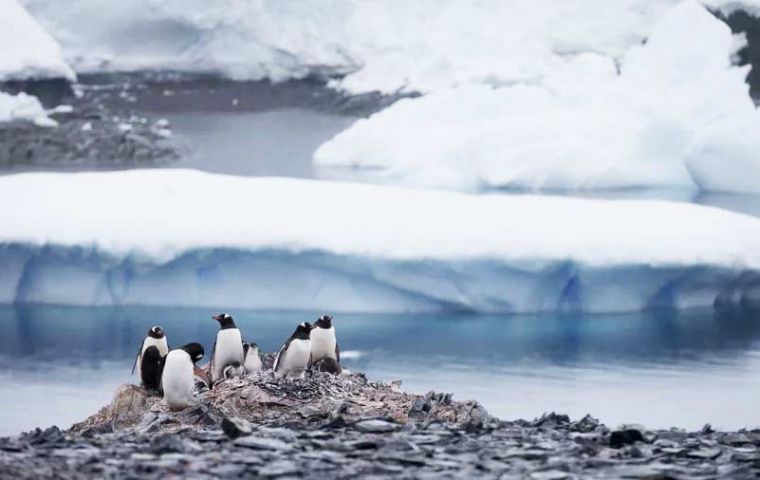MercoPress. South Atlantic News Agency
Record high temperature recorded in Antarctica
 New gear allowed for unprecedented measurements which showed certain species might be in danger (Pic AP)
New gear allowed for unprecedented measurements which showed certain species might be in danger (Pic AP) Recent measurements in Antarctica have reflected the effects of global warming when an unprecedented 34°C temperature was detected, thus setting a new record, it was reported. The findings stemmed from sensors attached to rocks in Fildes Bay in the coastal zone.
Previously, all maximum temperatures on the frozen continent had been measured by meteorological and atmospheric equipment. These could be the first temperature data on the rocks, where hundreds of marine organisms live and whose existence could be threatened.
The sensors were installed in February 2019 in the rocky area of Fildes Bay, King George Island, on the Antarctic Peninsula.
These devices are part of the “Pole to Pole Marine Biodiversity Observation Network of the Americas,” an international project in which more than 30 scientists collect information on various coasts of the American continent to study marine biodiversity.
The sensors, developed by researchers in Portugal, are attached to real mollusk shells or simulate their shape. Thanks to Near Field Communication (NFC) technology, it is possible to extract the data obtained from a cell phone, without the need for cables or the removal of the equipment.
The record of these temperatures was recovered by Erasmo Macaya, PhD, a researcher at the Center for Research on the Dynamics of High Latitude Marine Ecosystems (IDEAL) of the Universidad Austral de Chile (UACh) and a scholar at the Universidad de Concepción (UdeC).
The researcher installed several sensors as part of the Scientific Antarctic Expedition (ECA) 55 of the Chilean Antarctic Institute (INACH) three years ago. The devices were located on the rocky coast of Fildes Bay, near the Professor Julio Escudero base.
The recovery of this information was delayed due to the outbreak of the COVID-19 pandemic. However, during the last campaign, it was possible to recover the data from the devices, adding up to a total of three years of temperature.
“At one particular point, we had 34°C maximum, recorded during January 2022. It was a sensor that had been there since February 2020. In addition, several pieces of equipment exceeded 20°C. Even those installed in areas close to glaciers registered maximum temperatures of 14 to 16°C,” Macaya said.
He explained that “for these records, some conditions must be met, such as a clear day, little wind and low tide. However, these are temperatures measured in the substrate used by different marine organisms, such as invertebrates or algae, and which those with a certain degree of mobility can avoid. However, they are organisms adapted for a long time to very low temperatures or not so high fluctuations, so these peaks could have negative consequences.”
The information is added to the high records observed in different bases of the white continent during this summer. However, Macaya stressed that “it is difficult to make temperature comparisons because it depends on the location of the sensor. Data varies [depending on whether] they are installed in the open air or attached to a rock, but this information confirms that in the coastal zone, where animals and algae live, high values are being detected.”
In addition to data recovery, the scientist installed new sensors with greater strength and durability.




Top Comments
Disclaimer & comment rulesCommenting for this story is now closed.
If you have a Facebook account, become a fan and comment on our Facebook Page!